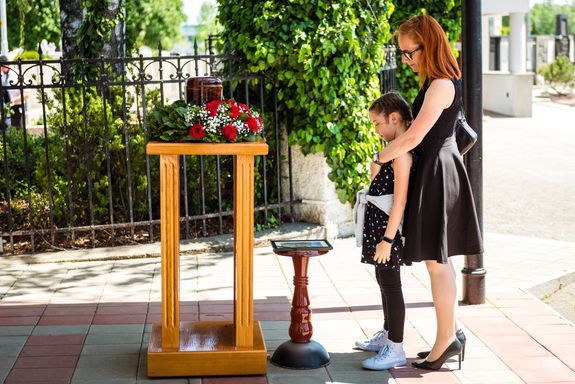All There is to Know About the Interment of Cremated Remains
Interment refers to the burying or placement of cremated remains in a memorial space dedicated for the purpose. Some of the most common areas to inter ashes include:
- Cemeteries
- Memorial gardens
- Urn gardens
- Columbariums
Why should interment be considered? Some religious practices, including Catholicism, discourage the scattering of ashes and promote that church members inter the ashes instead. There is a belief that the separation of the body separates the soul. Families also choose interment so they can visit their loved one and have a place of significance to visit and honor the departed.
It’s important to note that scattering ashes and interring them are two different things. Interment involves permanent (or at least long term) burial or display. As such, the regulations governing scattering and interment are slightly different.
Many people still want their final disposition to include interment in a cemetery, and cemeteries typically have spaces dedicated for interring ashes. They include:
● A traditional burial or family plot – Some cemeteries offer standard plots to people who still prefer cremation. Because cremation urns take up much less space, though, the cemetery may allow multiple urns in a single plot. This is ideal for people looking for a family plot.
If you’re considering interment in a cemetery, you’ll need to lease a burial plot as if you were burying an intact body. Plot leases are available for many years and give the owner permission to use that location for interment purposes.
A headstone is placed with the buried urn, as is custom in cemeteries.
● An urn garden – Some cemeteries dedicate areas just for burying urns. Called urn gardens, these areas consist of smaller plots designed to accommodate the smaller space that urns take up. Urn gardens are often beautifully landscaped, but there may be additional rules regarding what headstones can be placed with an urn.
● Columbariums – Columbariums are above-ground interment spaces, built into a small mausoleum-like structure. Columbariums are typically part of a larger cemetery and vary greatly in design and layout. Some are placed alongside urn gardens and burial areas, while others have their own dedicated building. In every case, columbarium spaces are leased like burial plots, allowing for long-term interment. Some spaces are large enough to take multiple urns, so they can be used by entire families.
Memorial gardens are also popular interment spots and are similar to cemeteries in what they offer. You’ll find traditional plots, columbariums and urn gardens here, but instead of a headstone, your loved one’s remains will be accompanied with a flat, engraved marker instead of a headstone.
If you wish to inter the ashes on private property, the rules are similar to those regarding scattering. You must have written permission from the property owner if you do not own the land yourself.
In most states, you do not require permission to bury the urn if you are the property owner. In fact, some people bury a loved one’s urn in their own yard. However, if you do bury the urn on your own property, you’ll need to either remove the urn if you sell the property, or alert the new property owners of the urn’s presence. It may be impossible to visit your loved one’s remains in the future if you do sell the property, so keep that in mind.
If you choose to bury the urn yourself, ensure it is buried at least 3 feet deep, with a bit of space on either side. This will keep the surrounding soil from shifting and possibly exposing the urn.
Whether you opt for a cemetery plot, columbarium or a piece of private land, you’ll need an urn to hold the ashes. The type of urn you’ll need depends on where it will be interred. Options include:
- Stone and metal urns – Urns made from stone and metal are durable and ideal for long-term interment underground. There are many types of durable urns, including urns made from granite, marble, stainless steel, brass, and pewter. Again, there are plenty of options, and these urns can also be used for display in columbariums or inside the home.
- Biodegradable urns – Biodegradable urns are made from wood or other materials designed to break down in the soil. They’re the choice for people who want a green form of disposition. Once buried, biodegradable urns decompose within a few weeks, allowing the remains to rejoin the earth.
- Ornamental urns – Ornamental urns are decorative and intended for display purposes. They are appropriate for columbariums or for a mantel and come in a variety of colors and designs. Decorative urns are typically made from ceramic and metals, and they can be used to memorialize the deceased without underground interment.
With cremation, memorial services can be arranged with complete flexibility. This includes arranging an interment service, where friends and family can gather, much like a funeral. In fact, some families opt for both funeral services and interment services.
Depending on where the service is held, it may include a religious ceremony along with readings, eulogies and other acts of remembrance. Loved ones have the opportunity to offer a few words and mourn together, so an interment service can be an act of closure for loved ones.
Many people find that interring a loved one’s ashes helps the grieving process. With a place to visit, it can be a comfort knowing that your loved one isn’t forgotten.
Fortunately, the process for interring ashes isn’t complicated, either. You can
pre-plan and pre-pay for the process, or you can choose to inter the ashes years after cremation. A
cremation service provider can help you with the process and recommend locations for interring ashes





